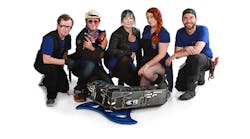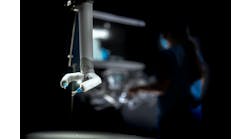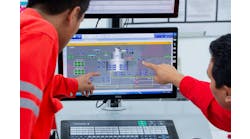A failed 2016 season of BattleBots on the Discovery Channel lit a fire under two now-members of Team Valkyrie.
“Fred and I were both on teams for the 2016 season that didn’t make it across the finish line for various reasons,” says Leanne Cushing, Captain of Team Valkyrie. “I was frustrated because it felt like I had wasted all that time I poured into it. I thought, ‘Next year, I’m going to have my own team and we’re not going to make the same mistakes.’”
Cushing pulled in Frederick Moore, Power Systems Engineer and Driver, a former intern Alexander Crease, Design Engineer and Outreach Coordinator, and others to form Team Valkyrie for the 2018 season.
“We knew we were going to work together and make a very pretty, very dangerous robot,” says Moore.
Robotic cult of personality
Not only does Team Valkyrie have to design a robot that can deliver harsh blows and withstand strong attacks, but it also has to have, among all things, a personality.
“It’s all part of designing a robot that’s going to be on TV,” says Crease. “We want to make something iconic that viewers will instantly recognize. Therefore, the character design is a very important part of the overall plan. Otherwise, all the robots would be giant boxes with spinning weapons on them.”
Team Valkyrie went with a sleek, powerful design that evokes a jet fighter or even a Star Wars star destroyer. Its modular weapons — known as the, “Sweet Caroline” (a brute force club), “Dr. Teeth” (a giant spinning disk with two prominent teeth), “Sonic the Wedgehog” (a blue spinning saw), and many more — all follow a specific weight limit to maintain overall consistency while giving the team options to trade damage for fast performance.
Sleek and strong
“There’s a bit of form following function in this design,” explains Moore. “We did have to make some design sacrifices to get that nice big ‘V’ shape, but there were some significant advantages as well. For example, the front panels of the robot are sloped, which gives us greater protection even with a thinner material. Our opponents come at us straight on but meet an angle — potentially bouncing off because of it.”
The robot’s looks can also be deceiving. While the exterior looks the same for every match, the team actually swaps out identically painted armor plates before each fight to optimize weight and strength ratios.
“This design is a little bit of our secret sauce. With all of our thickest armored panels, the robot would be well over 250-lbs. So, we swap out plates with different thicknesses and materials to best match who we’re fighting — some opponents hit from above, some come from underneath, some come at you with flippers, hammers, saws and more. So, we adapt our armor configuration to protect specifically against that opponent,” says Crease.
For example, if Team Valkyrie was going up against a robot with a hammer as its primary weapon, the team would place its heaviest armor on the top of their robot and use thinner armor on the sides.
Because Team Valkyrie has been fighting as a team since 2018, they’ve had the opportunity to refine their designs from previous seasons, as well as include more time for testing and optimization.
“We were able to test 10 different kinds of wheels and tires in order to find ones that gave us the very best grip in any circumstance,” says Moore. “We also noticed — especially with some of our 3D printing prototype work — that if we moved the wheel axles down 5 mm from their previous position, the robot drove twice as good.”
Lessons from the pit
“One thing we were able to refine this year was figuring out that so much of the competition is won in the pits,” says Moore. Being able to identify what went wrong during the fight — or even what could go wrong — when disassembling the robot is critical.
“We also learned that we always have to be ready, since we compete in back-to-back fights,” says Crease. “We would bring enough spares so that we could have three robots ready at once, giving us more time to repair after each match and really dial it in before the next fight.”
One tool Team Valkyrie used to help determine what they needed to adjust before the next match was a data logging system. “We were able to see the actual performance difference between our weapons and how much current each one was pulling from the batteries,” said Moore.
Based on the recommendations of engineers from sponsor TE Connectivity, a global industrial technology company that designs and manufactures connectors and sensors, Team Valkyrie programmed a microcontroller hooked up to an inductive current sensor to log current data going into its weapon motor and save it to an SD card. By testing various weapons with different Moment of Inertia (MOI) and spin-up profiles, the team formed a comprehensive study on the most efficient current limits to use during spin-ups, weighed against the mechanical and thermal limitations of the system. This informed them about which weapons would be best from a performance standpoint going into fights, and what each weapon’s resulting electrical limitations and drawbacks would be.
“Having that data gave us a deeper understanding of what was really going on with our robot. We were able to figure out any problems much quicker or even determine whether or not there was an issue in the first place,” says Cushing.
Tapping into application expertise
Team Valkyrie leveraged application expertise from a group of 17 TE Connectivity engineers from around the world to solve some of their unique challenges — including getting the data logging system up and running.
“This was a great project to work on and an opportunity for our global engineering team to consult on front-end design just like we would with any of our customers,” says Ricardo Hernandez, Industry Sales Manager at TE Connectivity. “In many ways Team Valkyrie was dealing with the same technical and environmental challenges our customers face daily in their industrial applications.”
“Those engineers helped us explore what was possible — where we could improve our system and overall design,” says Crease.
“They had a willingness to figure out solutions for doing live telemetry for us that worked within our own little hobby radio system. They gave us the solutions that we needed in a way that worked within our existing parameters,” says Moore. “Their assistance in helping us with a logged telemetry system gave us the confidence to leverage our data to make better decisions.”
In addition to the team’s telemetry and data logging systems, Team Valkyrie consulted TE Connectivity on their electric brake design. The brake’s safety system needed to dissipate the energy of the weapon disc within the one-minute time limit allowed in the rules.
“TE briefly assessed our choice of solid-state relay and film resistor as a resistive brake and confirmed that it was effective in safely discharging the energy from the weapon. Additionally, they proposed a new mechanical system based off of electrical solenoids and friction brakes that would actuate on the disc directly in the case of de-energization,” says Cushing. “While this would be a much safer system in the case of catastrophic robot failure, we concluded that the relay system would conserve weight and minimize mechanical complexity.”
Knowing they had expert recommendations coupled with sturdy components gave Team Valkyrie added peace of mind. “We know our electrical system is always good to go,” says Cushing. “We’re not going to have any connectors shake loose.”
Crease agrees. “We have a track record of breaking our opponents’ connectors and that’s never happened to us yet.”
Whether in the battle arena or on the job, Team Valkyrie is ready to rumble.




